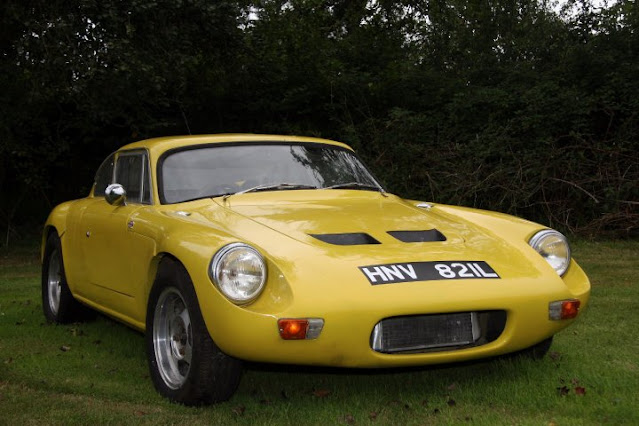 |
1969 Davrian MK3
|
Davrian Developments was founded by David Clarke and Adrian Evans in London, England in 1965. In 1976 the firm was moved to Tregaron, Dyfed, Wales and then to Lampeter, Dyfed in 1980.
Evans was a structural engineer and the designer of the car, which was originally based on components from the Hillman Imp, including; the front and rear suspension, the 875 or 998 cc aluminum alloy Hillman Imp engine, which was Coventry Climax-based, and the Imp transaxle.
 |
The prototype Davrian coupe (MK2)
|
After a series of prototypes, the design had settled to a 2-seat fiberglass monocoque coupé. It was officially called the "Davrian Imp" and series production started with the cars being sold in kit form. Over time, a variety of power units were offered including the Mini-engine Davrian Demon (mid-mounted), Volkswagen Beetle Type 1 (rear-mounted), Renault (rear-mounted) and Ford Fiesta (mid-mounted). Eventually, 8 distinct versions of the car were released and proved very popular as hill climb and circuit racing cars, in amateur hands.
 |
1981 Davrian MK8
|
In 1980, the company attempted to offer a "turn-key", factory produced car called the "Dragon" that featured a mid-engine configuration and Ford Fiesta running gear. However, economic conditions forced the company into receivership, due to insufficient capital for the endeavor by 1983.
 |
The Corry Cultra (scan from brochure)
|
In the wake of the bankruptcy, the rights to the Dragon were bought by Will Corry and production transferred to Lisburn, Northern Ireland, to be built by the newly founded Corry Car Company. The body was restyled by Tony Stevens and the name changed to the Corry "Cultra". Ford engines and were used and the suspension was based on that of the Mk III Cortina. The cars were mostly sold for competition use, but a few road-going versions were made. This effort ended in 1985.
Finally, in 1986, the rights to the Davrian design and tooling were returned to Wales and a new company was created by owner Tim Duffee, called Darrian Cars. Over the years, Darrian furthered development of the car for competition purposes, noting the original's popularity as a racer. They are still in operation and produce a variety of kits designed to accept a range of popular engine and transmission options.
 |
Darrian T90
|
Just goes to show that not every story in the history of the kit car industry ends in tears...
Sources:
 |
| 1967 Davrian MK1 |
 |
| 1969 Davrian MK3 |
 |
| 1970 Davrian MK4 |
 |
| 1970 Davrian MK4 |
 |
| 1970 Davrian MK4 |
 |
| 1971 Davrian MK5 |
 |
| 1971 Davrian MK5 |
 |
| 1971 Davrian MK5 |
 |
| 1975 Davrian MK6 |
 |
| 1981 Davrian MK8 |
 |
| Davrian MK8 |
 |
| 1978 Davrian MK7 |
 |
| 1972 Davrian MK5 |
 |
Corry Cultra
|
 |
Darrian T9
|
 |
| Darrian T9 |
 |
Darrian T90 The rear body work was designed by the
late Robin Herd, ex Formula 1 designer. This was his car. |
 |
| Darrian T90 GTR+ |
 |
| Darrian T90 GTR |
 |
| Darrian T90 (ex Robin Herd car) |





























The caption on XUO459K labels the car as 1970 Davrian Mk3, when it is actually a Davrian Mk5 from 1972. I owned this car for about 39 years from 1978 to 2018.
ReplyDeleteThank you, I appreciate the correction.
DeleteHi, we own the Davrian MK2 1967 prototype coupe (2nd picture) nice to see the original picture! It's a "sans hardtop" so has a removable roof!
ReplyDeleteThe blue Mk8 is a friend of mines car and in the next town from me. We need more Davrians in our lives!